Soccer drills
- Player 1 does exercises on the ladder
- At the end of the ladder is a ball
- With the ball he dribbles along pylons that are wide spread (conditioning)
- At the last pylon he shoots at a small goal
- Get your own ball, shoot back to the end of the ladder
- If player 1 is at the end of the ladder, player 2 can begin
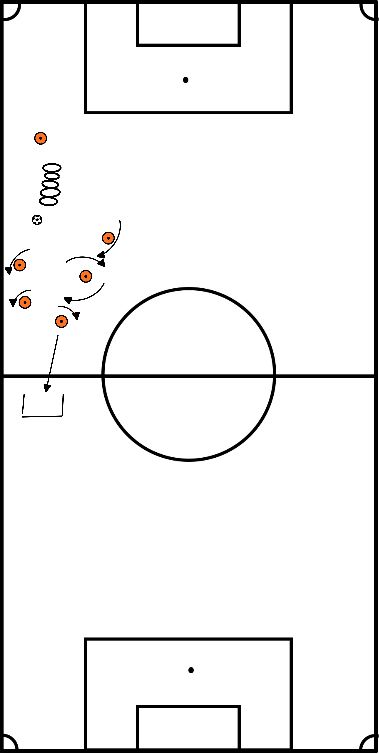
- The idea is to be able to play a game in corona time.
- The idea comes from a table soccer game
- Each player has his own space they are not allowed to leave.
- By passing, the ball can be brought to the other player
- Defense is allowed as long as it remains in his/her own discipline.
- The field can be adjusted to the number of players
Further goals:
- Passing
- Positioning game
- Shooting Distance
- The exercise can be made more difficult by making the game faster
- By only hitting the ball 2 or 3 times and playing quickly
- After all, during a match you don't have that much time either
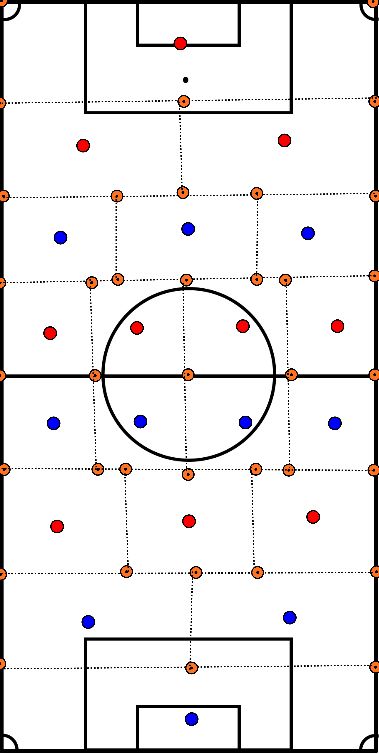
- Pass and kick with variations in finishing and build-up
- Keeper throws out, striker gets the ball and closes in
- Keeper shoots out, playing striker with back to goal, striker turns away
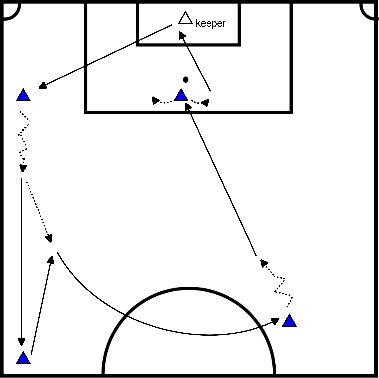
1 v 1
- Playing in
- Find each other
- Going in to win the duel
- Score or ball goes out
- Next pair starts
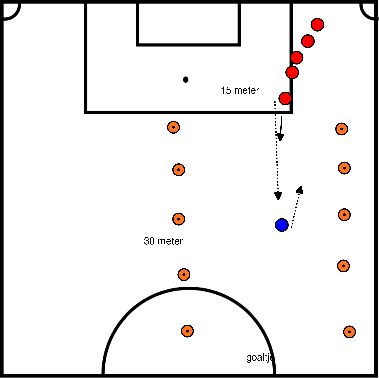
- 2 players walk along a row of pylons.
- Play the ball between the pawns to each other.
- Preferably hit 1x.
- Execute both left and right.
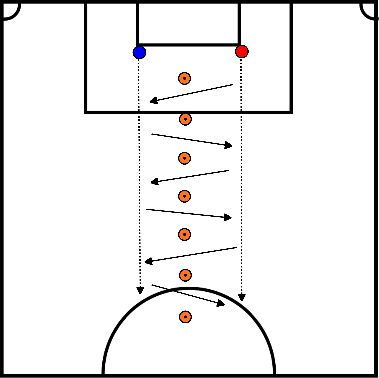
- Player 1 plays the ball to player 2.
- Behind player 2 is a defender.
- Player 2 turns left or right.
- Same as above but player 2 bounces back on player 1 who turned right (or left) and sprints away.
- Player 1 passes the ball in his feet.

- You can use this exercise if you want to work in positions with a defensive triangle.
- You can apply variations where necessary and also change the distances.
- This exercise has been given several times with youth teams as well as with the first teams.
- As you can see in the picture we work on 2 sides.
- Approximately the space from the 16m to the center line.
- First player plays the ball diagonally, player B turns with the ball and plays it to C who performs a 1/2 with B. C plays the ball deep on D. It connects to the other group.
- When A is past the zone the other group leaves.
- Passing on A-B-C-D.
- You can also replace player D by a goalkeeper.
- You can do enough variations in this warm-up exercise. An extra 1/2 for player D. Or player B who moves on the pass of C and responds to D. And so on.
- Let the exercise run for about 4 minutes before inserting a variation.
- Always emphasize the forward rotation of B.
- Take care of a short passing and a short acceleration after the pass at the end of the warming up.
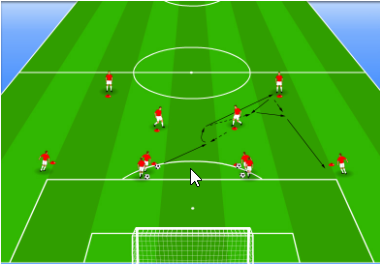
Exercise1 RUN STRAIGHT FORWARD
- Jog to the last pylon.
- Make sure your upper body is upright.
- Your hips, knees and feet should form a line.
- Don't let your knees buckle inwards.
- On the way back, run a little faster.
- Do the exercise twice.
Exercise 2 RAISE KNEE AND TURN UPPER LEG OUTWARDS WHILE RUNNING
- Jog to the first pylon.
- Stop and raise your knee forward.
- Turn your knee out and put your foot down.
- Keep your pelvis horizontal and your upper body still.
- The hip, knee and foot of the supporting leg together form a straight line.
- Do not let the knee of the supporting leg bend inwards.
- Jog to the next pylon and repeat the exercise with the other leg.
- When you have finished the course, jog back. Do the exercise twice.
Exercise 3 RAISE KNEE AND TURN UPPER LEG INWARDS WHILE RUNNING
- Jog to the first pylon.
- Stop and raise your knee sideways.
- Turn your knee inwards and put your foot down.
- Keep your pelvis horizontal and your upper body still.
- The hip, knee and foot of the supporting leg together form a straight line.
- Do not let the knee of the supporting leg bend inwards.
- Jog to the next pylon and repeat the exercise with the other leg.
- When you have finished the course, jog back.
- Do the exercise twice.
Exercise 4 RUNNING AROUND A PARTNER
- Jog to the first pylon.
- Shuffle sideways, at an angle of 90 degrees to your partner, shuffle a whole circle around each other (without changing your direction of view).
- and back to the first pylon.
- Bend your hips and knees slightly and move your body weight to the ball of your feet.
- Do not let your knees bend inwards.
- Jog to the next pylon and repeat the exercise.
- When you have finished the course, jog back.
- Do the exercise twice.
Exercise 5 JUMP AND TOUCH SHOULDERS WHEN RUNNING
- Jog to the first pylon.
- Shuffle sideways, at an angle of 90 degrees to your partner.
- Jump in the middle towards each other to make shoulder to shoulder contact.
- Land on both feet with your hips and knees bent.
- Do not let your knees bend inwards.
- Shuffle back to the first pylon.
- Jog to the next cap and repeat the exercise.
- When you are ready with the course, jog back.
- Do the exercise twice.
Exercise 6 RUN ACCELERATING AND SLOWING DOWN
- Run quickly to the second pylon
- and then run backwards to the first pylon;
- keep your hips and knees slightly bent.
- Always run two pylons forward and one back.
- When you're done with the course, jog back.
- Do the exercise twice.
- Put 2 chairs 18.3 meters apart.
- Put a tennis ball on chair 1 (this is always replenished), and put a bin on chair 2.
- The players work in pairs.
- One runs and the other keeps replacing the tennis balls.
- Collect as many tennis balls as possible in 9 minutes.
- It is not allowed to throw and you have to run around the chairs.
- Players in a circle hold each other's arms. pilons in the middle,
- Try to move the other one against a pilon.
- Whoever hits a pilon gets a penalty point.
- At 5 penalty points there will be prints etc.
- Number 1 plays 2 and plays a 1-2
- 1 opens to 3 which puts the ball ready for number 4.
- Number 4 finishes off on the goal with left leg.
- After this number 5 starts towards 6 etc. Number 8 finishes off with right foot.
- Player 1 stands on the edge of the 16 meter / 11 meter dot (depending on the level of the players)
- Player 2 stands on the edge of the centre circle and plays the ball in on player 1.
- Player 1 plays the ball to player 2.
- Player 2 shoots at goal.








